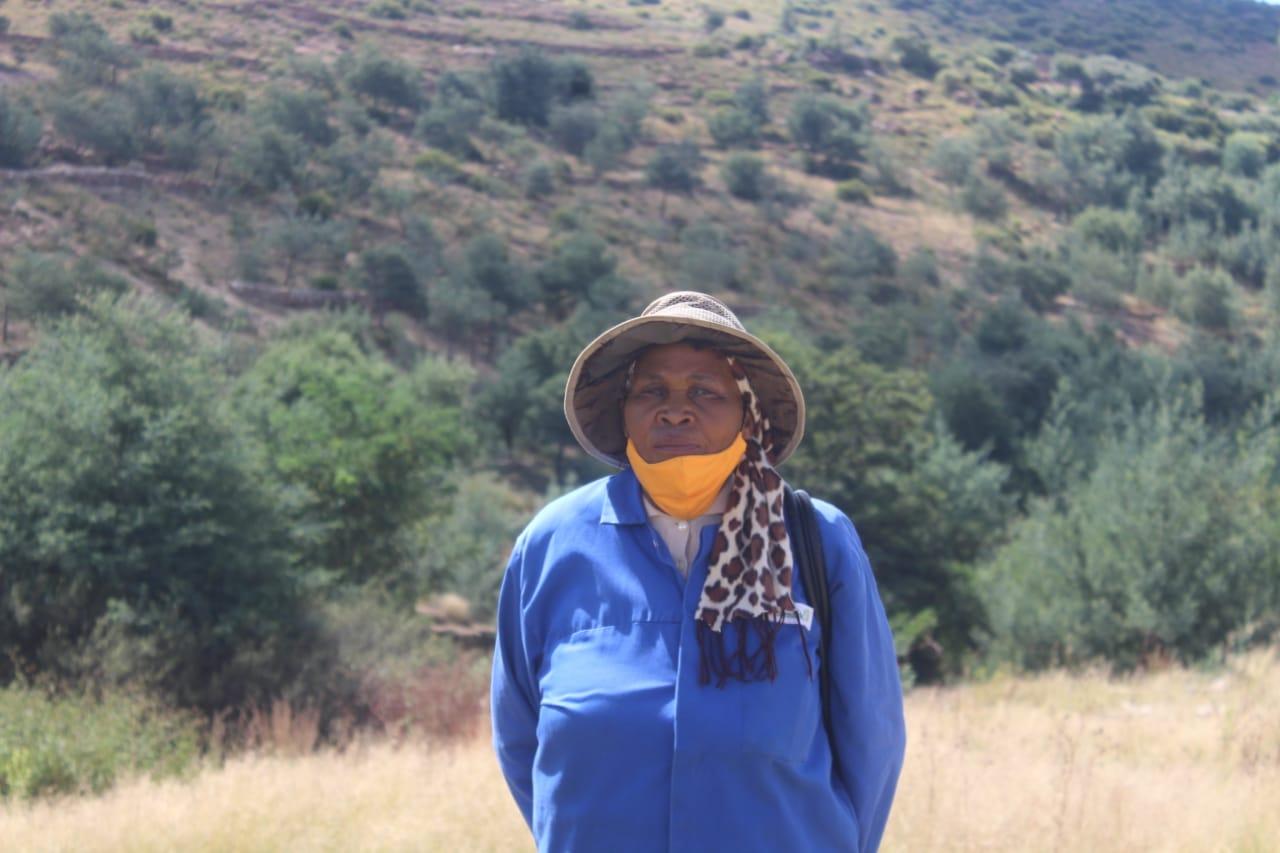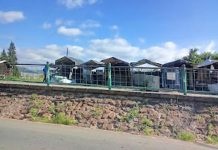Africa-Press – Lesotho. TEBOHO KHATEBE MOLEFI and MATHATISI SEBUSI While some world leaders reject the reality of climate change, and others continue to ponder how to act to allay its human, economic and environmental costs 63-year-old ’Maqenehelo Motšama vows her efforts to adapt will eventually dwarf this peculiar devastating global occurrence.
Walking briskly despite her age, Motšama says humanity has no reason to feel threatened and this is the mantra she repeats to the men and women of her village who see the surroundings they grew and played in slowly become uninhabitable – eroding and gradually failing to sustain their livelihood.
She has always been optimistic, and is not waiting for a miracle. She says she believes in standing up and making sure she doesn’t become a statistic of indolence by succumbing to the wrath of climate change.
On the other side of the planet, it is April 8 and the president of the crucial UN climate conference, COP26, observes that the world is “a long way off” from meeting the goals of the landmark Paris Agreement on climate change.
The British politician, Alok Sharma, was speaking during global discussions on the green transition in sectors such as energy, transport and food systems, held as part of the 2021 Spring Meetings of the World Bank and the International Monetary Fund (IMF).
“Oceans are warming, storms are intensifying, and yet we are a long way off meeting the goals of the Paris Agreement,” Sharma told the virtual meeting.
“Unless we act now, the human, economic and environmental cost will overshadow anything that humanity has seen before.
”
COP26, which will be held this November in Glasgow, Scotland, aims to accelerate action towards the Paris Treaty goals which focus on limiting global temperature rise to 1.5 degrees above pre-industrial levels by curbing greenhouse gas emissions.
John Kerry, the US Special Presidential Envoy for Climate, calls this conference “the last best opportunity we have to get real and serious. ” Kerry particularly urges developed countries to step up efforts to reduce emissions.
He says: “It is essential that we raise ambition, that people of the world make Glasgow the next step in defining not what we’re willing to do but what we really need to do in order to be able to get the job done.
”
If all pledges made so far were fulfilled, global emissions would fall by one percent by 2030, compared with the 2010 levels, according to the UN Secretary General António Guterres, who says the first assessment of promises made amounts to a “red alert for our planet.
”
But scientists say a 45 percent reduction in the next 10 years to keep global heating to no more than 1.5C above pre-industrial levels is needed to be safe.
This first assessment of countries’ pledges to cut greenhouse gas emissions in the next decade has found that they are only a fraction of the effort needed to avoid climate breakdown. This reduction is a vital component of the Paris climate agreement.
According to the National Inventory Report, ‘Lesotho’s 4th National Greenhouse Gas Inventory: 2011 to 2017,’ the country’s greenhouse emissions (GHG) have increased by 83.7 percent from 3 080.7Cg CO2e in 1994 to 5 660.447Cg CO2e in 2017.
The country’s GHG national inventory for the energy sector is made up of the manufacturing industries and construction, transport (civil aviation and road transport) as well as other sectors, including the commercial, residential and agricultural (forestry, fishing and fish farms).
According to the World Bank data, total greenhouse gas emissions for 2010 was 3 425.28, a 25.56 percent increase from 2009; emissions for 2011 was 3 449.41, a 0.7 percent increase from 2010 while emissions for 2012 was 3 472.71, a 0.68 percent increase from 2011.
This gloomy picture strangely urges ’Maqenehelo on, though she does not understand much of the scientific explanations, warnings and theories debated by environmental and climate change pundits.
But she says she has, at least, grasped that humankind has destroyed the world and that the planet is reacting in a fashion dangerous to its populations.
She says now is not the time to simply theorise, but to save what remains unblemished in the world for the survival of future generations; each in their little way wherever they are – to adapt.
And with climate change already having this negative impact on Lesotho, robust integrated policies and strategies have been put in place to initiate and improve existent adaptive capacity of the country’s citizens; and with this high exposure to climate, variability extremes are expected in weather patterns and are increasing in frequency and intensity.
A sectoral vulnerability assessment to climate change was carried out on key sectors of agriculture, water resources, forestry, rangelands, and health and subsequently a National Adaptation Programme of Action (NAPA) was developed in 2007 outlining proposed adaptation needs to address projected climatic changes.
Since 2007, a number of efforts have been undertaken by various role players in the climate change adaptation field in Lesotho with support from government, development partners and non-state players.
’Maqenehelo is a resident of Ha Mansuloane, Siloe, in Taung Mohale’s Hoek – a weather-beaten region of Lesotho’s dry southern districts some 124km from the capital Maseru.
She recalls that the first signs that something was getting terribly wrong with her village’s environment was when they could not produce as much food as they used to.
To address climate change impacts and rehabilitate the environment, while also increasing communities’ resilience to climate change, the government through the Ministry of Forestry, Range and Soil Conservation and the Lesotho Meteorological Services (LMS) and World Food Programme (WFP) have embarked on a project called Improving Adaptive Capacity of Vulnerable and Food Insecure Populations in Lesotho (IACoV).
The four-year IACoV project is financially supported by an adaptive fund to the tune of M150 million, executed by the Government of Lesotho through the Ministry of Forestry, Range and Soil Conservation and the LMS and implemented by WFP.
The project intends to address the barriers of climate change adaptation by strengthening capacity of the government on early warning signs while ensuring that optimal knowledge and utilisation of climate information are tailored to community needs.
Speaking to this publication, IACoV project coordinator, Nkopo Matsepe, said the project, which started in October 2020, is expected to turn around the livelihoods of the vulnerable people it is targeting by the time the four-year project comes to an end.
The project intends to address the barriers to climate change adaptation by strengthening the capacity of the Lesotho government on early warning signs while ensuring optimal knowledge and utilisation of climate information tailored to community needs.
He said through the project, communities are empowered to plan and implement appropriate resilience building activities that will transform lives and diversify livelihoods.
Matsepe added that the project focuses mainly on women and children that are most vulnerable and affected by climate change and have no means to survive. The project has three components.
Component One focuses on strengthening government capacity to generate climate information and promote its use to forecast risks of climate shocks, mobilise early actions, and co-develop tailored and locally relevant climate services for communities.
“Component Two concentrates on raising awareness of communities, women, youth, people living with HIV, and other vulnerable groups on the impacts of climate change, the importance of adaptation, and the use of climate information for seasonal planning and climate risk management.
“Component three focuses on empowering communities to understand community-based planning processes that facilitate implementation of appropriate resilience building and adaptation interventions that generate sustainable assets ensuring income diversification and market access,” he said.
Due to climate change the Southern side of the country has been experiencing severe food shortages. Apart from land degradation, a lot of fields have been swept away by heavy rains that the southern districts experienced early last year.
IACoV field officer in the Quthing district of the country, Tšoanelo Oliphant, also notes that land rehabilitation projects and vegetable projects are the kind of interventions that communities can start to increase their resilience to climate change.
Oliphant says when mountains are covered with grass and indigenous herbs, grazelands and wet lands are restored, while communities are able to have more water and grass for their livestock.
He says land rehabilitation, especially in the grazing pastures, helps control water flow consequently reducing land degradation. This is the same initiative that has brought a new sense of living to ’Maqenehelo and her village neighbours.
She states that this and other communal projects they have been engaged in to turn around the effects of climate change on their surroundings remain the only and most convenient way to survive.
The hardest-hit surroundings of Ha Mansuloane that have turned into defiled grassless patches of land and dry gorges are slowly being rehabilitated through ‘Fato-Fato’ communal projects to set up household vegetable gardens, and silts across eroded areas.
“Working together to rehabilitate our surroundings and ensuring each household has, at least, a vegetable garden to feed itself might look simple and pointless, but is a start which if done by each member of the community can ensure that we live…despite the hardships brought about by the chilling effects of climate change,” she says.
The World Economic Forum reports that many technologies that could help countries adapt to the consequences of climate change already exist. It notes that this can be through, among others, planting scientifically engineered crops that grow faster.
Farmers can harvest them before, say, cyclone season, which will become increasingly violent as global temperatures rise. However, there remains significant barriers to adoption – barriers that governments should dismantle through a combination of incentives, regulatory reform, and institutional upgrading.
The report says the benefits of such action would extend beyond increased climate resilience. “Accelerating harvests would mean higher, more reliable production with less labour – a formula for stronger, more stable livelihoods.
“Policymakers should thus pursue integrated solutions that combine climate-change adaptation and mitigation with broader societal concerns, including development,” reads the report.






